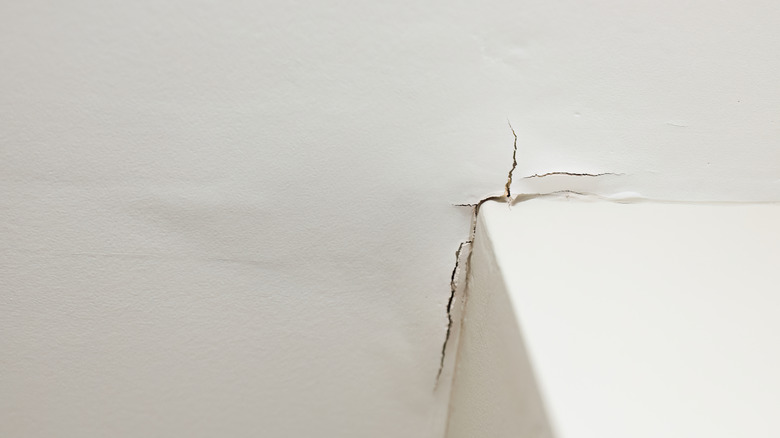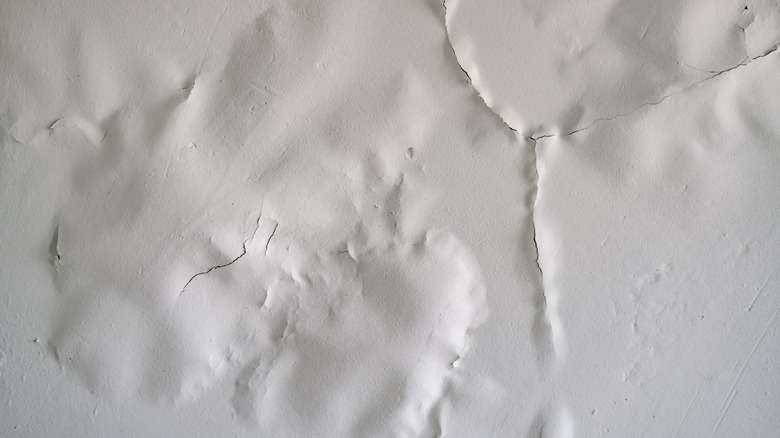Types Of Ceiling Cracks And What They Mean For Your Home
It can be very disconcerting to see a crack forming in your ceiling, leaving you wondering whether you have costly repairs ahead of you like replacing the foundation of the home or something equally catastrophic. In reality, different types of cracks can happen for different reasons, and some luckily have simple remedies. To help readers solve this issue in their homes, we spoke with House Digest's expert carpenter and remodeler Bob Beacham, who explained what kinds of cracks to look out for, as well as how to get rid of them.
"Most common are thin cracks that either run in more-or-less straight lines or resemble a spider web," says Beacham. Finding a spiderweb crack in the ceiling is very normal, but "They should be no more than 1/16 [of an inch wide]," Beacham adds, as larger cracks can mean something more severe for your home. In addition to spiderweb cracks, Beacham says, "There could also be larger cracks accompanied by discolored patches and/or sagging." These types make up the two major categories of ceiling cracks that are often found in homes. Beacham also offers us the reasons why these cracks occur, when you should start worrying about the cracks in your ceiling, and how to fix them.
How to eliminate ceiling cracks
In order to effectively repair cracks, it's necessary to understand why they happen in the first place. In an exclusive interview with House Digest, our expert carpenter and remodeler Bob Beacham walks us through this. When it comes to spiderweb cracks, Beacham says, "Thin cracks are caused by natural movement of the house due to settling or seasonal changes in temperature and humidity." This could be the result of a house simply expanding and contracting with seasonal change, or a sign of badly installed drywall. Thankfully, according to Beacham, these types of cracks don't always require a major fix: "Fine cracks that don't 'grow' can often be painted over." With the help of a ceiling repair kit, you can fix unsightly cracks in your ceiling.
On the other hand, Beacham explains, "Discoloration and/or sagging is usually caused by rain getting in through the roof or other water leak." But that's not the only cause: "Sagging may also point to a problem with ceiling supports caused by insect infestation (especially termites) or a structural problem. Cracks that also run down the walls could be a sign of a structural problem." Unfortunately, these types of cracks may require the help of a professional. Beacham advises, "If there's discoloration, the source of the leak needs to be found and remedied, then the ceiling can be repaired. If there are cracks and sagging without discoloration, call an exterminator. If the cracks are large, or they also go down a wall, call a structural engineer ASAP," especially if they are expanding.
Can you prevent ceiling cracks?
There's no doubt it's preferable that cracks never happen in the first place. Bob Beacham spoke with House Digest in an exclusive interview to give tips on minimizing the risk of ceiling cracks. Unfortunately, as he says, "It's almost impossible to avoid drywall cracks caused by age and the natural movement of a house." These are simply a normal part of a house's life. On the plus side, Beacham cheekily adds, "Look at it as notification that it's time to redecorate that room you've been putting off doing."
When it comes to avoiding more severe sagging and bulging cracks, preventative measures are your best bet. A few recommendations from Beacham include regularly checking on the roof and loft to identify leaky spots and insect damage before they can get worse, and potentially booking an annual exterminator appointment. Otherwise, he says to keep an eye on the house's exterior, and look out for signs of water seeping into the foundation, or the appearance of rot near doors or porch supports. In the end though, Beacham says, "Unfortunately, sometimes there's little you can do except act quickly when you see signs of trouble." So be proactive when you notice cracks forming in your ceiling, and repair issues as they happen instead of allowing them to play out.


